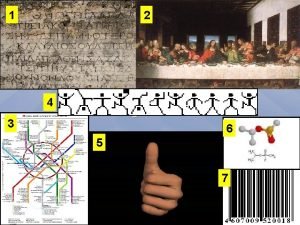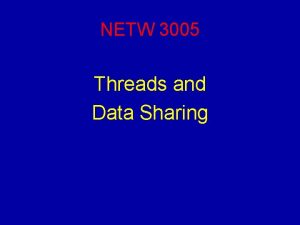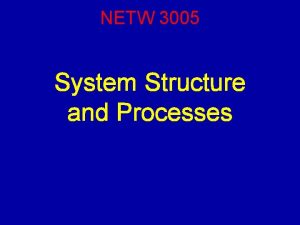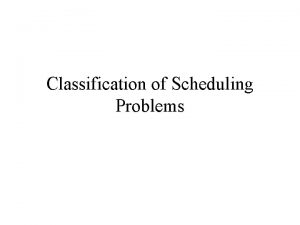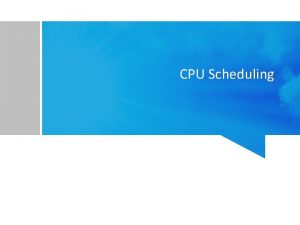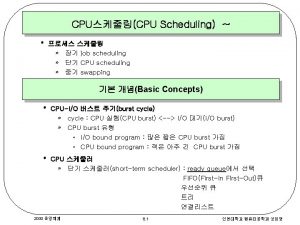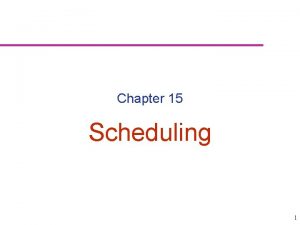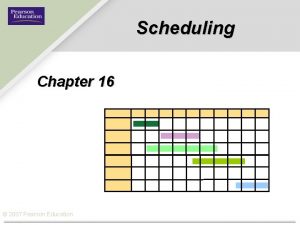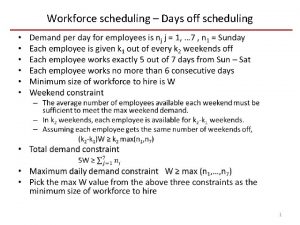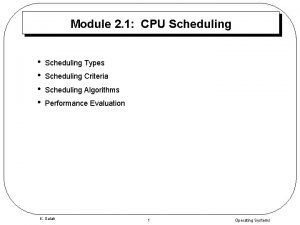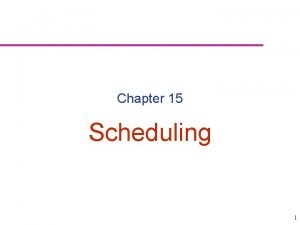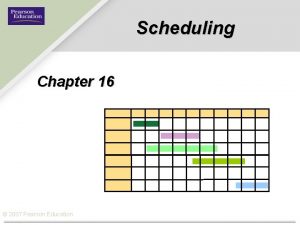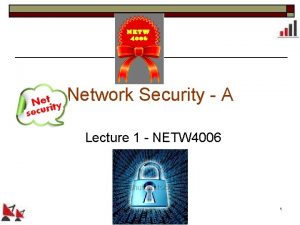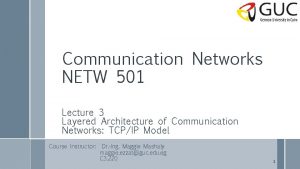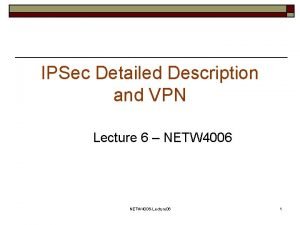NETW 3005 Scheduling Reading For this lecture you





























































- Slides: 61

NETW 3005 Scheduling

Reading • For this lecture, you should have read Chapter 5 (Sections 1 -3, 7). NETW 3005 (Operating Systems) Lecture 04 - Scheduling 2

Last Lecture • Cooperating processes and datasharing NETW 3005 (Operating Systems) Lecture 04 - Scheduling 3

This lecture • Criteria for scheduling algorithms • Some scheduling algorithms: – first-come-first-served, – shortest-job-first, – priority scheduling, – round-robin scheduling, – multilevel queue scheduling. NETW 3005 (Operating Systems) Lecture 04 - Scheduling 4

Important Notice • There is a TUTORIAL TEST on CPU scheduling in tutorial 10 B (8 -9 May). • It’s worth 9. 5%. • The questions in Tutorial 10 A are practice for this exam. NETW 3005 (Operating Systems) Lecture 04 - Scheduling 5

CPU scheduling: a recap ready queue I/O I/O device queue CPU I/O request fork interrupt mechanism NETW 3005 (Operating Systems) Lecture 04 - Scheduling 6

Context switching Process P 0 Operating System executing Process P 1 idle Interrupt or system call save state into PCB 0 reload state from PCB 1 idle executing Interrupt or system call save state into PCB 1 reload state from PCB 0 executing NETW 3005 (Operating Systems) idle Lecture 04 - Scheduling 7

Scheduler and dispatcher • The scheduler decides which process to give the CPU to next, and when to give it. • Its decisions are carried out by the dispatcher. • Dispatching involves: – Switching context – Switching to ‘user mode’ – Jumping to the proper location in the new process. NETW 3005 (Operating Systems) Lecture 04 - Scheduling 8

Why do we want a scheduler? (1) • Simple answer – to keep the CPU busy. • This means removing processes from the CPU while they’re waiting. • If processes never had to wait, then scheduling wouldn’t increase CPU utilisation. • However, it’s a fact that processes tend to exhibit a CPU burst cycle. NETW 3005 (Operating Systems) Lecture 04 - Scheduling 9

How long is a CPU burst? • Simple answer – it varies depending on machine and job mix. • Typically, majority are around 4 – 6 ms. NETW 3005 (Operating Systems) Lecture 04 - Scheduling 10

Why do we want a scheduler? (2) • Another reason for having a scheduler is so that processes don’t have to spend too much time waiting for the CPU. • Even if the CPU is always busy, executing processes in different orders can change the average amount of time a process spends queuing for the CPU. NETW 3005 (Operating Systems) Lecture 04 - Scheduling 11

P 1 NETW 3005 (Operating Systems) P 2 P 3 Lecture 04 - Scheduling P 4 12

Why do we want a scheduler? (3) • One question is how long a process spends waiting for the CPU in total. • A different question is how long, on average, it waits in between visits to the CPU (important for interactive processes. ) NETW 3005 (Operating Systems) Lecture 04 - Scheduling 13

Metrics for scheduling algorithms(1) • CPU utilisation: the percentage of time that the CPU is usefully busy. • Throughput: the number of processes that are completed per time unit. • Turnaround time (per process): the elapsed time between submission time and completion time. NETW 3005 (Operating Systems) Lecture 04 - Scheduling 14

Metrics for scheduling algorithms(2) • Waiting time (per process): the total amount of time the process spends waiting for the CPU. • Response time (per process): the average time from the submission of a request to a process until the first response is produced. NETW 3005 (Operating Systems) Lecture 04 - Scheduling 15

The ready queue • Remember: there are two kinds of waiting: – Waiting for the CPU (in the ready queue) – Waiting for an I/O device (in a device queue). • Don’t be confused when you hear about processes waiting in the ready queue! NETW 3005 (Operating Systems) Lecture 04 - Scheduling 16

Preemption • In a non-preemptive scheduling system, a process keeps the CPU until it switches to the waiting state (pending I/O completion or termination of a child process), or terminates. • In a preemptive scheduling system, the currently executing process can be removed from the CPU at any time. NETW 3005 (Operating Systems) Lecture 04 - Scheduling 17

Interrupts • A possible context switch is triggered – when a new process arrives in the ready queue; – when a waiting process finishes waiting; – when a certain amount of time has elapsed. NETW 3005 (Operating Systems) Lecture 04 - Scheduling 18

Problems • What if a process is preempted while a system call is being executed? Kernel data (e. g. I/O queues) might be left in an inconsistent state. • Earlier versions of UNIX dealt with this problem by waiting until system calls were completed before switching context. NETW 3005 (Operating Systems) Lecture 04 - Scheduling 19

Preemptive systems • MS Windows 3. 1 and below were nonpreemptive. • Windows 95, NT, XP etc are preemptive. • Linux is fully preemptive as of 2. 6. • Mac. OS 9 and earlier versions weren’t (although they claimed to be). Mac. OS X is. NETW 3005 (Operating Systems) Lecture 04 - Scheduling 20

Gantt charts • The operation of a scheduling algorithm is commonly represented in a Gantt chart. Process P 1 P 2 P 3 Arrival time Burst time t 1(= 0). b 1 t 2 b 2 t 3 b 3 (N. B. We’re just looking at the initial CPU burst for each process. ) NETW 3005 (Operating Systems) Lecture 04 - Scheduling 21

First-come-first-served scheduling • The simplest method is to execute the processes in the ready queue on a firstcome-first-served (FCFS) basis. • When a process becomes ready, it is put at the tail of the queue. • When the currently executing process terminates, or waits for I/O, the process at the front of the queue is selected next. • This algorithm is non-preemptive. NETW 3005 (Operating Systems) Lecture 04 - Scheduling 22

Gantt Charts for FCFS Process P 1 P 2 P 3 Arrival time 0 1 2 P 1 P 2 24 P 1 P 2 P 3 NETW 3005 (Operating Systems) Burst time 24 3 3 Lecture 04 - Scheduling P 3 27 30 23

Waiting times? • • P 1? P 2? P 3? Average? NETW 3005 (Operating Systems) Lecture 04 - Scheduling 24

Waiting times? • • P 1? 0 ms P 2? P 3? Average? NETW 3005 (Operating Systems) Lecture 04 - Scheduling 25

Waiting times? • • P 1? 0 ms P 2? 24 – 1 = 23 ms P 3? Average? NETW 3005 (Operating Systems) Lecture 04 - Scheduling 26

Waiting times? • • P 1? 0 ms P 2? 24 – 1 = 23 ms P 3? 27 – 2 = 25 ms Average? NETW 3005 (Operating Systems) Lecture 04 - Scheduling 27

Waiting times? • • P 1? 0 ms P 2? 24 – 1 = 23 ms P 3? 27 – 2 = 25 ms Average? (0 + 23 + 25) / 3 = 16 ms NETW 3005 (Operating Systems) Lecture 04 - Scheduling 28

Gantt Charts for FCFS (2) Process P 1 P 2 P 3 P 2 Arrival time 2 0 1 P 3 3 Burst time 24 3 3 P 1 6 30 P 1 P 2 P 3 NETW 3005 (Operating Systems) Lecture 04 - Scheduling 29

Waiting times? • • P 1? P 2? P 3? Average? NETW 3005 (Operating Systems) Lecture 04 - Scheduling 30

Waiting times? • • P 1? 6 – 2 = 4 ms P 2? P 3? Average? NETW 3005 (Operating Systems) Lecture 04 - Scheduling 31

Waiting times? • • P 1? 6 – 2 = 4 ms P 2? 0 ms P 3? Average? NETW 3005 (Operating Systems) Lecture 04 - Scheduling 32

Waiting times? • • P 1? 6 – 2 = 4 ms P 2? 0 ms P 3? 3 – 1 = 2 ms Average? NETW 3005 (Operating Systems) Lecture 04 - Scheduling 33

Waiting times? • • P 1? 6 – 2 = 4 ms P 2? 0 ms P 3? 3 – 1 = 2 ms Average? (4 + 0 + 2) / 3 = 2 ms NETW 3005 (Operating Systems) Lecture 04 - Scheduling 34

Advantages of FCFS • Easy to implement. • Easy to understand. NETW 3005 (Operating Systems) Lecture 04 - Scheduling 35

Disadvantages of FCFS • Waiting time not likely to be minimal. • Convoy effect: lots of small processes can get stuck behind one big one. • Poor response time — bad for timesharing systems). • Q: could throughput (no of processes passing through the system per unit time) be improved? NETW 3005 (Operating Systems) Lecture 04 - Scheduling 36

Shortest-job-first scheduling • If we knew in advance which process on the list had the shortest burst time, we could choose to execute that process next. • Processes with equal burst times are executed in FCFS order. • This method is called shortest-job-first (SJF) scheduling. NETW 3005 (Operating Systems) Lecture 04 - Scheduling 37

Example P 4 3 NETW 3005 (Operating Systems) Process P 1 P 2 P 3 P 4 Burst time 6 8 7 3 P 1 P 3 9 Lecture 04 - Scheduling P 2 16 24 38

Advantages of SJF • Provably optimal average waiting time. NETW 3005 (Operating Systems) Lecture 04 - Scheduling 39

Disadvantages of SJF • You never know in advance what the length of the next CPU burst is going to be. • Possibility of long processes never getting executed? NETW 3005 (Operating Systems) Lecture 04 - Scheduling 40

Predicting CPU burst length • It’s likely to be similar in length to the previous CPU bursts. • A commonly-used formula: the exponential average CPU burst length. τn+1 = α tn + (1 − α)τn τn: the predicted length of CPU burst n. tn: the actual length of CPU burst n. α: a value between 0 and 1. NETW 3005 (Operating Systems) Lecture 04 - Scheduling 41

Preemption and SJF scheduling • Scenario: – A process P 1 is currently executing. – A new process P 2 arrives before P 1 is finished. – P 2’s (predicted) burst time is shorter than the (expected) remaining burst time of P 1. • Non-preemptive SJF: P 1 keeps the CPU. • Preemptive SJF: P 2 takes the CPU. NETW 3005 (Operating Systems) Lecture 04 - Scheduling 42

Tiny example (with preemption): Process P 1 P 2 P 1 0 Arrival time 0 1 P 2 1 NETW 3005 (Operating Systems) Burst time 8 4 P 1 5 Lecture 04 - Scheduling 12 43

Priority scheduling • In priority scheduling: – each process is allocated a priority when it arrives; – the CPU is allocated to the process with highest priority. • Priorities are represented by numbers, with low numbers being highest priority. NETW 3005 (Operating Systems) Lecture 04 - Scheduling 44

Questions • Can priority scheduling be preemptive? NETW 3005 (Operating Systems) Lecture 04 - Scheduling 45

Questions • Can priority scheduling be preemptive? Yes, no reason why not. NETW 3005 (Operating Systems) Lecture 04 - Scheduling 46

Questions • Can priority scheduling be preemptive? Yes, no reason why not. • What’s the relation of SJF scheduling to priority scheduling? NETW 3005 (Operating Systems) Lecture 04 - Scheduling 47

Questions • Can priority scheduling be preemptive? Yes, no reason why not. • What’s the relation of SJF scheduling to priority scheduling? SJF is a type of priority scheduling, specifically one where the priority of a process is set to be the estimated next CPU burst time. NETW 3005 (Operating Systems) Lecture 04 - Scheduling 48

Starvation and aging • Starvation occurs when a process waits indefinitely to be allocated the CPU. • Priority scheduling algorithms are susceptible to starvation. – Imagine a process P 1 is waiting for the CPU, and a stream of higher-priority processes is arriving. – If these processes arrive sufficiently fast, P 1 will never get a chance to execute. NETW 3005 (Operating Systems) Lecture 04 - Scheduling 49

Starvation and aging • A solution to the starvation problem is to increase the priority of processes as a function of how long they’ve been waiting for the CPU. (Called aging. ) NETW 3005 (Operating Systems) Lecture 04 - Scheduling 50

Round-Robin scheduling • Round-robin (RR) scheduling is designed for time-sharing systems. • A small unit of time (time quantum) is defined. • The ready queue is treated as a circular list. • The CPU scheduler goes round the ready queue, allocating the CPU to each process for a time interval of up to 1 time quantum. NETW 3005 (Operating Systems) Lecture 04 - Scheduling 51

RR Example Process P 1 P 2 P 3 Arrival time 0 1 4 Burst time 8 4 4 Assume that the time quantum is set to 3 NETW 3005 (Operating Systems) Lecture 04 - Scheduling 52

RR Example (continued) P 2=1 P 1=5 P 1 0 P 2 3 NETW 3005 (Operating Systems) P 3=1 P 1=2 P 1 6 P 2=0 P 3 9 P 1=0 P 3=0 P 2 P 1 P 3 12 13 15 16 Lecture 04 - Scheduling 53

Changing the Time Quantum • If the time quantum is set to be infinitely large, RR scheduling reduces to FCFS scheduling. • If the time quantum is set to be very small, we can talk of processor sharing. • If we make the time quantum the same as the context switch time, we’ll spend half our time on context switching! NETW 3005 (Operating Systems) Lecture 04 - Scheduling 54

RR: advantages and disadvantages • If the time quantum is big, we get the advantages/disadvantages of FCFS scheduling. • If it’s very small, we get faster response time but slower throughput. • Why? NETW 3005 (Operating Systems) Lecture 04 - Scheduling 55

RR: advantages and disadvantages • If the time quantum is big, we get the advantages/disadvantages of FCFS scheduling. • If it’s very small, we get faster response time but slower throughput. • Why? Because there’s more time spent context-switching. NETW 3005 (Operating Systems) Lecture 04 - Scheduling 56

RR: advantages and disadvantages • Even if you ignore context-switch time, turnaround time goes down if most processes complete within a single quantum. • For instance, say there are 3 processes with a next CPU burst of 10. – If the quantum size is 1, then average turn-around time is 29. – If quantum size is 10, then they finish in the next CPU burst, and the average turnaround time is 20. NETW 3005 (Operating Systems) Lecture 04 - Scheduling 57

Multilevel queue scheduling • Let’s say you have two groups of processes: – interactive processes; – batch processes. • What you really want is to run different scheduling algorithms for the two groups. NETW 3005 (Operating Systems) Lecture 04 - Scheduling 58

Multilevel queue scheduling • Split the ready queue into a number of different queues, each with its own scheduling algorithm. • Implement a scheduling algorithm to decide which queue is allocated next. • Preemptive priority scheduling is often used. NETW 3005 (Operating Systems) Lecture 04 - Scheduling 59

Exercise The Linux command nice changes priority for a process. Read the man page for nice. Using any Linux program, try the following: /bin/nice -n 19 <program> /bin/nice -n 10 <program> Is there a difference in speed? (You may want to use the time command as well. ) NETW 3005 (Operating Systems) Lecture 04 - Scheduling 60

Next Lecture Process Scheduling Chapter 6 (Sections 1– 7).
 0001 0011
0001 0011 Job scheduling vs process scheduling
Job scheduling vs process scheduling While reading activities
While reading activities 01:640:244 lecture notes - lecture 15: plat, idah, farad
01:640:244 lecture notes - lecture 15: plat, idah, farad Fspos
Fspos Typiska novell drag
Typiska novell drag Tack för att ni lyssnade bild
Tack för att ni lyssnade bild Vad står k.r.å.k.a.n för
Vad står k.r.å.k.a.n för Shingelfrisyren
Shingelfrisyren En lathund för arbete med kontinuitetshantering
En lathund för arbete med kontinuitetshantering Adressändring ideell förening
Adressändring ideell förening Personlig tidbok för yrkesförare
Personlig tidbok för yrkesförare Sura för anatom
Sura för anatom Förklara densitet för barn
Förklara densitet för barn Datorkunskap för nybörjare
Datorkunskap för nybörjare Boverket ka
Boverket ka Att skriva debattartikel
Att skriva debattartikel Magnetsjukhus
Magnetsjukhus Nyckelkompetenser för livslångt lärande
Nyckelkompetenser för livslångt lärande Påbyggnader för flakfordon
Påbyggnader för flakfordon Kraft per area
Kraft per area Offentlig förvaltning
Offentlig förvaltning Kyssande vind
Kyssande vind Presentera för publik crossboss
Presentera för publik crossboss Jiddisch
Jiddisch Vem räknas som jude
Vem räknas som jude Treserva lathund
Treserva lathund Mjälthilus
Mjälthilus Claes martinsson
Claes martinsson Centrum för kunskap och säkerhet
Centrum för kunskap och säkerhet Lågenergihus nyproduktion
Lågenergihus nyproduktion Mat för idrottare
Mat för idrottare Verktyg för automatisering av utbetalningar
Verktyg för automatisering av utbetalningar Rutin för avvikelsehantering
Rutin för avvikelsehantering Smärtskolan kunskap för livet
Smärtskolan kunskap för livet Ministerstyre för och nackdelar
Ministerstyre för och nackdelar Tack för att ni har lyssnat
Tack för att ni har lyssnat Referatmarkering
Referatmarkering Redogör för vad psykologi är
Redogör för vad psykologi är Matematisk modellering eksempel
Matematisk modellering eksempel Atmosfr
Atmosfr Borra hål för knoppar
Borra hål för knoppar Vilken grundregel finns det för tronföljden i sverige?
Vilken grundregel finns det för tronföljden i sverige? Formel för standardavvikelse
Formel för standardavvikelse Tack för att ni har lyssnat
Tack för att ni har lyssnat Rita perspektiv
Rita perspektiv Ledningssystem för verksamhetsinformation
Ledningssystem för verksamhetsinformation Tobinskatten för och nackdelar
Tobinskatten för och nackdelar Blomman för dagen drog
Blomman för dagen drog Handledning reflektionsmodellen
Handledning reflektionsmodellen Egg för emanuel
Egg för emanuel Elektronik för barn
Elektronik för barn Antika plagg
Antika plagg Strategi för svensk viltförvaltning
Strategi för svensk viltförvaltning Var 1721 för stormaktssverige
Var 1721 för stormaktssverige Ellika andolf
Ellika andolf Romarriket tidslinje
Romarriket tidslinje Tack för att ni lyssnade
Tack för att ni lyssnade Uppställning multiplikation
Uppställning multiplikation Vad är lyrik
Vad är lyrik Inköpsprocessen steg för steg
Inköpsprocessen steg för steg Rådet för byggkompetens
Rådet för byggkompetens
